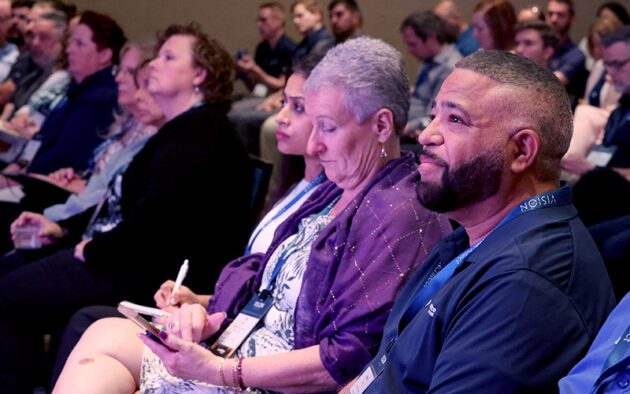Determining which employees will work which shift—employee rostering—is time-consuming and challenging for managers. Effective employee rostering requires a deep understanding of the workforce, including each employee’s skills and certifications. This ensures that the right worker is matched with the right task, improving productivity, and maintaining smooth operations.
Different types of workers have unique needs. A one-size-fits-all workforce management software approach, whilst tempting for simplicity’s sake, essentially ignores the workforce needs.
A Modern Approach to Workforce Rostering
Managers who are overwhelmed by employee rostering can turn to WorkForce Software to increase efficiency, improve productivity, and modernise their workforce.
“Management focus on the employee experience has become highly correlated with the ability to attract and retain top talent, not unlike the benefits of delivering a superior customer experience.”
Quincy Valencia, VP and Research Director, Ventana Research
WorkForce Software solutions help managers respond quickly to workforce disruptions. They feature fair and predictive employee rostering tools that gather valuable data on workers’ skills and hours worked. Managers can use this data to meet their employees’ needs adequately whilst helping to create a suitable work/life balance.
Our rostering tools also keep the necessary focus on compliance, which can be a constantly moving target. It can be difficult to keep track of every detail to ensure operations are meeting regulatory requirements. The right employee rostering programs can help navigate these challenges, keep the organisation compliant and support worker satisfaction.
WorkForce Software helps managers take a modern approach to employee rostering to fully support the different teams in your workforce. This reduces discrepancies between worker types, cuts unnecessary competition for hours and decreases the chaotic and unproductive nature of manual employee rostering. The software can also help ensure a productive mix of employees to encourage collaboration and address both the needs of the business and its workers.
WorkForce Software can help modernise the employee rostering of deskless shift workers in a variety of verticals, including manufacturing, retail, education, the public sector, healthcare and natural resource businesses.
Employee Rostering by Skill-Level
One way that our solutions modernise employee rostering is by factoring in employee skill-level. Managers can be strategic and intentional by including workers with more experience in the same shifts with workers who are newer, rostering employees who have the strengths and weaknesses to complement each other. This strategy creates a balanced environment where co-workers learn from and with one another.
Additionally, managers can factor in other aspects to ensure they roster the right workers for each shift. With digital rostering capabilities, managers can also look at qualifications, updated certifications and availability to configure dynamic employee rostering. Using these competency criteria will help ensure only workers who are a fit for the job are rostered.
With WorkForce Software, employers have access to a complete worker profile allowing them to log in and update their own employee data. The employee profile tracks shift history and other performance indicators. This employee-generated information also helps the system to find workers best suited for each project.
Employee Rostering by Multiple Groups
Another benefit of WorkForce Software’s solution is its ability to assist with employee rostering for diverse groups of workers. Not all labour is alike, and organisations may have a combination of full-time and part-time deskless shift workers. According to labour laws, each employee type has different requirements for minimum and maximum hours. Workforce management programs enable managers to ensure consistency and compliance.
Let’s consider several scenarios to highlight how these tools can assist with rostering:
Scenario 1: Planning for Part and Full-Time Workers in Retail
In a retail store with part-time and full-time workers and two managers, WorkForce Software’s employee rostering software calculates the number of part-time workers to roster for each shift based on the tasks required and the hours needed. A project that requires twenty-five hours could be completed in one day by five part-time workers, each working five hours.
For full-time workers, the manager could roster three full-time workers to work eight-hour shifts. The goal of employee rostering with WorkForce Software is to meet the demands of both the organisation and the employee.
Scenario 2: Meeting Requirements in Manufacturing
For a manufacturing project requiring workers with specific ASQ certifications and three years of experience, WorkForce Software can identify qualified workers to include in shifts and eliminate workers who do not meet the minimum requirements, acting as a safety net to ensure compliance with all processes and procedures necessary to avoid legal risks and fines.
Our workforce management software helps enable more flexibility with different types of workers and documenting their shifts. Employees can enter their own time into the system, including blocking off their availability and noting hours worked. Managers can verify the data and use it to plan for future employee rostering. This is especially important for seasonal workers.
Scenario 3: Balancing Experience Levels
Employee rostering software can balance experienced and inexperienced staff. Creating employee rosters around high-performing and reliable deskless shift workers increases productivity.
If the goal is to optimise labour spend and reduce office space even further, the organisation may choose employee rostering based on a combination of their availability and business needs.
Productivity, Efficiency, and Optimisation
Managers should consider being flexible, predictable, and accessible when creating employee rostering strategies for deskless shift workers. These workers need employee rostering tools that help them plan their work/life balance and have access to their employee data.
Employees need to know that their availability and requests for time off will be acknowledged and factored into the weekly employee rostering process. When employees feel employers are responsive to their needs, they are likely to be more engaged, productive, and loyal to their organisation.
Enhancing Employee Experience with WorkForce Software
WorkForce Software’s rostering capabilities deliver the flexibility employees expect with the coverage employers want including:
- Gives employees visual access to their rosters, clearly displaying when they are expected to work. It can show weekly, biweekly, and even monthly rosters. Once employee rostering has been entered, managers can use previous shift information to create future shifts. Knowing when they will work helps employees plan their lives around their work rosters, which is crucial for a healthy work/life balance.
- Accessibility from a desktop, phone, or any device with an internet connection. Employees can review their rosters, note changes, updates, and even claim available rosters. They can review previous shifts and confirm any information already entered.
- Provides managers with the means and technology to intelligently manage the often-overwhelming process of employee rostering. The software helps with managing shifts and planning for annual leave requests in a precise and efficient way.
Supporting Diverse Teams and Strengthening Workforce Experience
With all these benefits, WorkForce Software offers comprehensive tools for flexible employee rostering that meets both employee and employer needs. Our data gathering functions, ease of communication, focus on compliance and dedication to employee satisfaction set us apart.
Powerful data gathering functions, ease of communication, compliance cognisant and employee satisfaction focused — learn what it can do for your organisation today.




